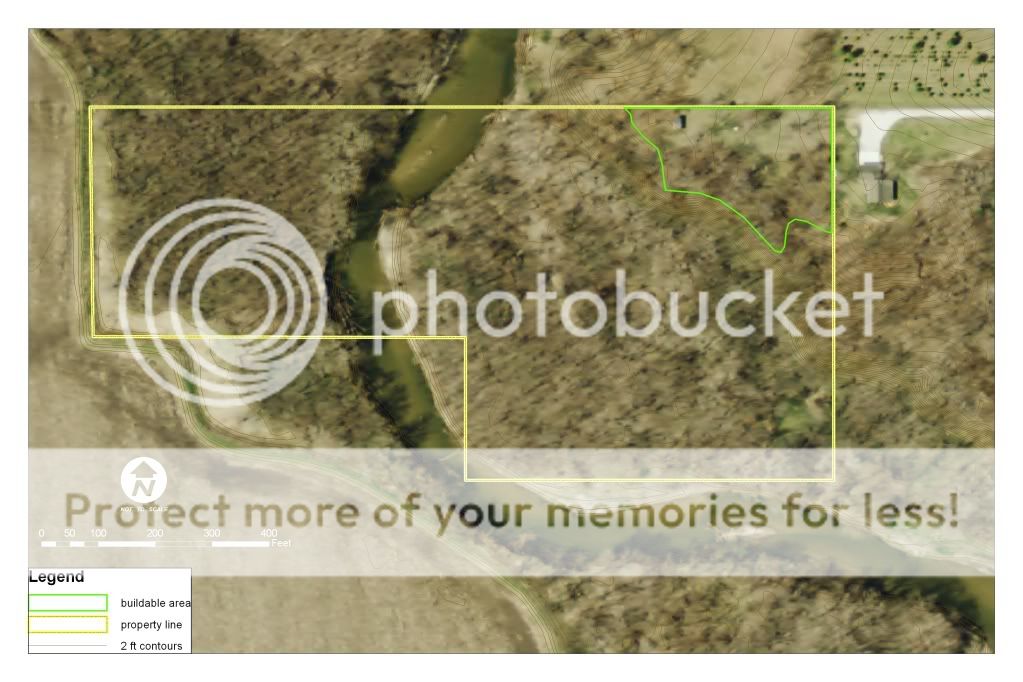










The ultimate goal of farming is not the growing of crops, but the cultivation and perfection of human beings. - Masanobu Fukuoka

 1
1




"Instead of Pay It Forward I prefer Plant It Forward" ~Howard Story / "God has cared for these trees, saved them from drought, disease, avalanches, and a thousand tempests and floods. But he cannot save them from fools." ~John Muir
My Project Page




Yes, I have a water right, but I'm not sure of the details. I'm east of the Missouri River, so water rights aren't that big of a deal here (at least not yet). This year was a drought, but most of the last 10 years we've had too much water. Definitely too flat for hydro, but I like the idea of a small pump to keep a pond or livestock tank full. The challenge with a pond in the area between the green boundary and the creek is that it is low and flat, with a 25 foot steep bank down to the floodplain at the SW side of the green boundary, and 10 stream bank. I could dig a little depression that would hit groundwater very shallow and hold floodwater. That'd be great for encouraging diversity and wildlife, but probably not reliable for fish production. Ducks/geese would love it, but they'd be easy pickin's for coyotes, fox, and other predators down there. An island would help, but there are mink, muscrats, and raccoons, too.Michael Newby wrote:Do you have water rights to any of the water flowing in that creek?
That could be a great asset for you, maybe use a ram pump to fill a pond for ducks/geese and to water livestock, maybe get a little hydro power out of it - doesn't look like you have the drop to really go all out hydro power though.
I'm familiar, but need to read more about them. We would have a relatively conventional house (i.e., no earth bags, cob, yurt, etc), so I'm wondering about the "insurability" of homes with rocket mass heaters. We may build a very heavily insulated metal shed with in-floor heat that runs off an outdoor boiler (and can also use LP). With that, I'd love a rocket mass heater or an old-fashioned wood cook stove.Michael Newby wrote:As far as wood heat, are you familiar with the Rocket Stove Mass Heater that's discussed heavily in the wood heat forum here? They're a great option, especially with the access you have to wooded land.
Yes, loads of cottonwoods and silver maples for hugelkulture. But again, the flatness of the area between the green boundary and the creek means the whole area is practically on contour. And, floodplain regs would not allow me to build up hugel beds in that area. Of course, that's happening naturally all over the place down there, as fallen trees/branches collect soil and things grow on them. I do want some hugel beds up in the buildable area, but space is limited so I'll have to pick my spots well.Michael Newby wrote:If your forest is predominantly cottonwood and you're wanting to convert to other species then you could clear 90% of the cottonwoods along with thinning some of the other trees for overall stand health. All these trimmings would be great fodder for Hugelbeds, which I personally would place on contour all over the property on the east side of the river, maybe leaving the farthest east/south-east area to be converted to a less forested silviculture area for some livestock.
Yep, so much to do that this area will be largely untouched for years, expect for foraging and perhaps some game harvesting. May try to get a few oaks and edible understory plants going, though.Michael Newby wrote:I'd say to try to keep the forest on the west side of the creek more "wild" working on native game forage and timber/other forest resources.
I'm thinking about having a few pigs on the east side of the creek, but definitely want to get some swamp white oak and/or burr oak going. I also want to try and get some red maples going to replace some of the many silver maples. Reds are better for syrup production. Great link to the food plot mix - thanks a lot for that!Michael Newby wrote:If you keep a few pigs and go heavy on the oaks on the west side, you could run the pigs through the woods in the fall to fatten them up and there's a good chance that if there's deer in your area they'll love the acorns too. I'd personally add some chestnut trees and other nut trees to the mix also - great forage for the animals and the people! Outside Pride sells a deer forage mix (http://www.outsidepride.com/seed/deer-food-plots/sweet-spot-northern-mix.html) that's supposed to be pretty good for understory planting for attracting deer and it'd make decent fodder for other animals also.










Iterations are fine, we don't have to be perfect
My 2nd Location:Florida HardinessZone:10 AHS:10 GDD:8500 Rainfall:2in/mth winter, 8in/mth summer, Soil:Sand pH8 Flat









| I agree. Here's the link: http://stoves2.com |





